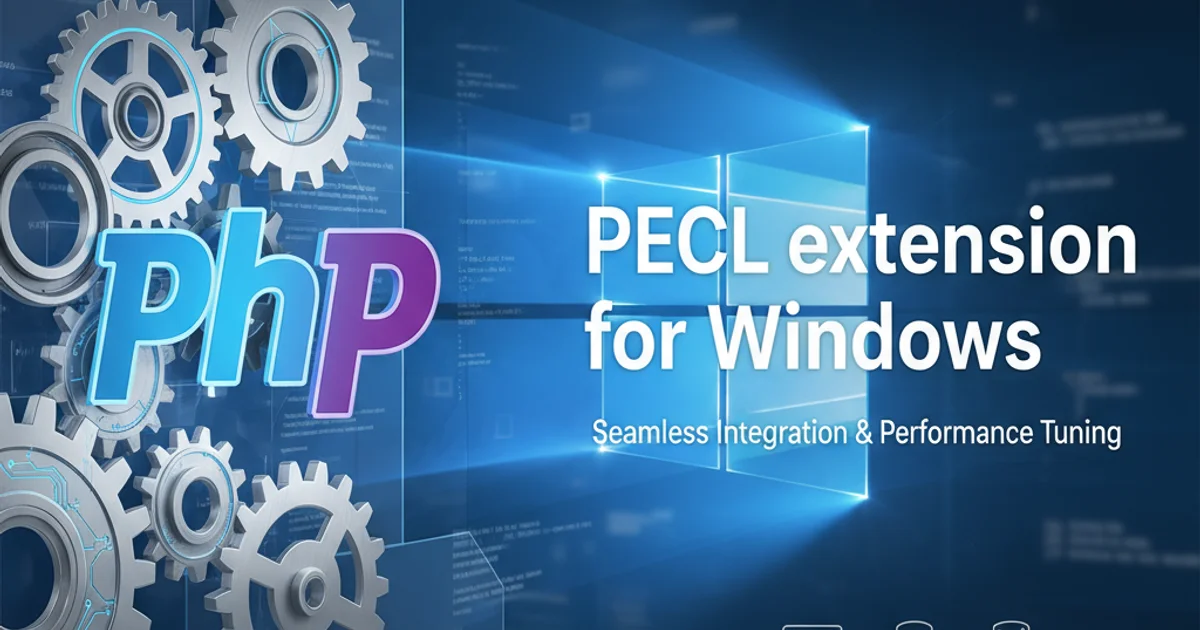PECL extension for Windows
Categories:
Installing PECL Extensions for PHP on Windows

A comprehensive guide to finding, downloading, and installing PECL extensions for your PHP environment on Windows, covering common pitfalls and best practices.
PHP Extension Community Library (PECL) provides a repository of extensions for PHP, offering additional functionality not built into the core language. While installing PECL extensions on Linux is often straightforward using the pecl command-line tool, the process on Windows requires a more manual approach. This article will guide you through the steps to successfully integrate PECL extensions into your Windows PHP setup.
Understanding PECL Extensions and Windows Compatibility
PECL extensions are typically written in C and compiled into .dll (Dynamic Link Library) files for Windows. The most crucial aspect of installing these extensions is ensuring compatibility with your specific PHP version, architecture (x86 or x64), and compiler (Thread Safe - TS or Non Thread Safe - NTS). Mismatched versions are the primary cause of installation failures.
flowchart TD
A[Start: Identify PHP Environment] --> B{PHP Version?}
B --> C{Architecture (x86/x64)?}
C --> D{Thread Safety (TS/NTS)?}
D --> E[Search PECL for Extension]
E --> F{Find Compatible DLL?}
F -- No --> G[Consider Alternatives/Compile from Source]
F -- Yes --> H[Download DLL]
H --> I[Place DLL in ext/ Directory]
I --> J[Edit php.ini]
J --> K[Restart Web Server/PHP-FPM]
K --> L[Verify Installation]
L --> M[End: Extension Ready]Flowchart for installing PECL extensions on Windows.
Step-by-Step Installation Guide
Follow these steps carefully to install your desired PECL extension on Windows.
1. Step 1: Determine Your PHP Environment
Before downloading any extension, you need to know your PHP version, architecture, and thread safety. Create a phpinfo.php file with <?php phpinfo(); ?> and access it through your web server. Look for the following key pieces of information:
- PHP Version: e.g.,
7.4.27 - Architecture:
x86orx64(often indicated by 'Compiler' or 'Architecture' fields) - Thread Safety:
enabled(TS) ordisabled(NTS). This is crucial for matching the correct DLL.
2. Step 2: Find and Download the PECL Extension DLL
Visit the official PECL website at pecl.php.net. Search for your desired extension. Once found, navigate to its download page. You'll typically find a list of releases. Look for a release that matches your PHP version. On the release page, you'll see a section for 'Windows downloads'. Download the .zip file that corresponds to your PHP version, architecture (x86/x64), and thread safety (TS/NTS).
For example, if you have PHP 7.4, x64, NTS, you would look for a file like php_redis-5.3.7-7.4-nts-vc15-x64.zip.
3. Step 3: Extract and Place the DLL
Extract the downloaded .zip file. Inside, you'll find one or more .dll files (e.g., php_redis.dll). Copy the relevant .dll file(s) into your PHP installation's ext directory. This directory is usually located at C:\php\ext or C:\xampp\php\ext.
4. Step 4: Configure php.ini
Open your php.ini file for editing. This file is typically located in your PHP installation directory (e.g., C:\php\php.ini or C:\xampp\php\php.ini). Add a new line at the end of the file, or within the 'Dynamic Extensions' section, to enable your extension. The format is extension=your_extension_name.dll.
For example, to enable the Redis extension, you would add:
extension=php_redis.dll
5. Step 5: Restart Your Web Server/PHP-FPM
For the changes in php.ini to take effect, you must restart your web server (Apache, Nginx, IIS) or PHP-FPM service. If you are using PHP CLI, simply opening a new command prompt will load the new configuration.
6. Step 6: Verify Installation
Re-run your phpinfo.php script or execute php -m from the command line. Search for your newly installed extension. If it appears in the output, the installation was successful.
; Dynamic Extensions
; ... other extensions ...
extension=php_redis.dll
extension=php_mongodb.dll
Common Issues and Troubleshooting
Even with careful steps, you might encounter issues. Here are some common problems and their solutions:
- PHP Startup: Unable to load dynamic library 'php_extension.dll' - The specified module could not be found. This usually means the DLL file is not in the
extdirectory or the path inphp.iniis incorrect. Double-check the file's location and theextension=line. - PHP Startup: Unable to load dynamic library 'php_extension.dll' - %1 is not a valid Win32 application. This error indicates a mismatch in architecture (e.g., trying to load an x64 DLL into an x86 PHP, or vice-versa). Re-verify your PHP environment and download the correct DLL.
- PHP Startup: Unable to load dynamic library 'php_extension.dll' - The specified procedure could not be found. This often points to a compiler mismatch (e.g., VC11 vs. VC15) or a thread safety mismatch (TS vs. NTS). Ensure the DLL's compiler and thread safety match your PHP build.
- Extension not appearing in
phpinfo(): After adding theextension=line and restarting, if the extension still doesn't show up, check your web server's error logs for any PHP startup errors. Also, ensure you're editing the correctphp.inifile that your web server is using (check the 'Loaded Configuration File' inphpinfo()).
php-sdk can assist with this.